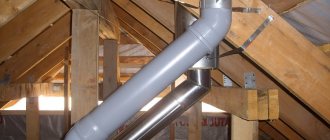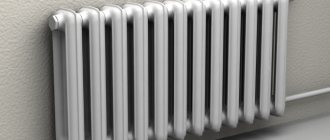Those people who are faced with issues of supplying gas to their home have to deal with various difficulties and obstacles from the gas service. The most important thing is that the legislation does not collect all the norms and requirements for equipping a boiler room in a private building in a separate document. Therefore, the country's gas producers can manipulate the requirements at their discretion, paying attention to some details and reducing their vigilance in other cases. But the basic requirements of gas workers in different regions are still largely similar. The requirements for a gas boiler room are aimed at complying with safety regulations for working with gas-powered heating appliances. They are aimed at minimizing losses from gas leaks and explosions.
Is it possible to install a shower, toilet and washing machine in the boiler room?
Is it possible to install a gas boiler in the same room as a shower stall?
author: Sergey
Is it possible to install a shower stall in the same room with a double-circuit gas boiler in a private house, subject to all safety rules for operating gas equipment? If not, what is the reason for this?
Best regards, Victor Danilchenko
It will be better if the booth is installed at a distance of at least a meter from the boiler. This way the gas workers will be calm, and you will be safer. You can also make a partition between the boiler and the cabin. But in any case, you need to consult with gas workers.
Is it possible to install a shower stall in the same room as a gas boiler?
Good afternoon Please tell me, is it possible to install a shower stall in a room where a gas boiler is located?
Is it possible to install a shower, toilet and washing machine in the boiler room?
Hello. Tell me, is it possible to install a shower, toilet, and washing machine in a boiler room of 9 m2, 25 m3? Beretta boiler 24 kW, water heater 180 l?
Theoretically possible, practically difficult. There are many regulations governing the installation of gas equipment. These are SNiPs 41-01-2003, 2.04.08-87, 31-02-2001, 42-01-2002, SP 42-101-2003 and a number of departmental documents. Nowhere is there a direct prohibition on installing a gas heat generator in a combined bathroom, but this is what a room with a shower, washbasin and toilet should be called. You definitely cannot place the boiler only in living rooms. Allowed in kitchens and separate rooms not located in the basement and meeting SNiP standards.
The basic requirements for installing a boiler of the power you specified are:
The total volume of the room must be at least 7.5 m3 (for the kitchen 13.5 m3); Ceiling height from 2 meters; The presence of natural exhaust and inflow, providing three air exchanges within an hour; The room must have a window with a net glazing area of at least 0.8 m2 with a standard glass thickness of 4 mm. It is necessary to ensure that combustion products are removed from the boiler in accordance with building codes and manufacturer's requirements.
But there are additional requirements.
All heating equipment placed in a room with high humidity (namely, a shower room) must have an anti-corrosion design. Let's say you convinced the relevant authorities of this. Let's say the passports of your boiler, pump and voltage stabilizer indicate that the electrical equipment has an increased class of protection against moisture, not lower than IP 44 . Let's say you managed to maintain all the necessary distances from plumbing to heat-generating appliances, this is at least 60 cm. There is still the problem of electrical outlets: according to existing standards, there should not be any in the bathroom. You can connect the devices directly or install special waterproof sockets, and route the wiring through sealed cuffs . Theoretically, if these conditions are met, it is allowed to combine a furnace room and a bathroom. Although, from a technical point of view, this is really not the best solution. In addition to the boiler itself, you will also have to install a boiler, pumping group, pipelines and other equipment. Will it be possible to rationally place all this in the bathroom?
In practice, the decision depends on how your local gas authorities interpret the concept of “separate room” . From the point of view of construction terminology, this is any room separated by a door from the common space. From the point of view of gas workers, this is a room intended only for the installation of heating equipment. They are calm about placing a washbasin in the furnace room, they rarely object to a washing machine, but, as a rule, they are categorically against the presence of a shower, bath, steam room, or complex electrical equipment in the boiler room. In addition, gas service specialists are right: from a technical point of view, this is really not the best solution. Domestic standards directly allow the placement of a gas boiler in the kitchen. This may be the best solution for you. Again, theoretically, one can argue with this approach. There are rare cases where developers managed to implement such a solution, proving that there are no direct prohibitions on installing a gas boiler in the bathroom. However, if you are not ready to get involved in long disputes, bother with additional documents, coordinate technical details and their implementation with biased inspectors of gas, fire and energy services, we advise you to think about an alternative solution. You can get more detailed information first-hand from your regional gas service.
Gas workers appeal only with fears for our lives in the event of a gas leak, and they do not have any SNiPs about the placement of shower cabins in furnace rooms.
9.32 The installation of water heaters, heating boilers and heating devices should be provided in kitchens and furnaces that meet the requirements of 9.37 and 9.38. Installation of these devices in bathrooms is not allowed .
And yet, according to our passport, this room is not a bathroom, but a furnace room, which meets the requirements of 9.37 and 9.38. So, nowhere in these requirements is there a ban on installing showers, toilets and sinks in furnace rooms. Or am I not right?
That is, if a gas boiler is made “of anti-corrosion materials or with protective coatings against corrosion,” then it can even be installed in a bathroom? I’ll try to “fight” with the designers.
· internal gas pipelines and gas equipment of industrial, administrative, public and domestic buildings where gas is used for food preparation or laboratory purposes;
· autonomous heating and hot water supply systems for administrative, public and domestic buildings with boilers and heat generators, without generating thermal energy for production purposes and (or) providing services with the total thermal power of installed equipment less than 100 kW.
Source
About installation rules
There are a number of requirements for installing gas equipment:
- The vast majority of models need to be located in a separate room. The exception is wall-mounted units - they can be mounted in non-residential rooms, for example, in the kitchen or bathroom, if their size allows. Before installing the boiler, it is necessary to ensure the required ventilation in the boiler room.
- The volume of premises for the installation of gas equipment with a closed chamber is not regulated, but the area must comply with the standards. In addition, the unit must have an outlet to the flue. It is unacceptable to bring it near the ventilation ducts.
- Horizontally located parts of the gas duct cannot be more than 3 meters long and have more than three turns. The flue outlet must be raised above the roof level by at least a meter.
- Wall-mounted models are mounted at a distance of 800 mm or more from the floor surface. No objects should be placed under the boiler, and a metal sheet must be laid on the floor. An expansion tank and an air valve must be installed.
Gas equipment cannot be installed in the following types of premises:
- In the apartments of an apartment building without a main gas flue - these are the majority of old buildings.
- In rooms with false ceilings and capital mezzanines.
It is almost impossible to install a floor model in an apartment in a multi-storey building. After all, this will require serious redevelopment with all the ensuing problems and costs. There are no restrictions on the installation of such equipment in a private home. Here it is better to make a separate boiler room, for example, in an extension. This room must meet the following standards:
- Entrance doors are no narrower than 80 cm.
- There must be a chimney that goes either to the roof or through the wall to the outside.
- The height of the boiler room must be at least 2.2 m. The room is equipped with a ventilation system.
A double-circuit boiler with automation will require a separate branch of electrical wiring. An additional 20 A circuit breaker is installed on it. It is advisable to provide backup power to the automation, capable of maintaining its operation in normal mode at least for a day. To do this, you can purchase a diesel generator or a UPS - an uninterruptible power supply.
Severe demands are placed on the gas duct. Its minimum diameter is 110 mm, regardless of the power of the installed equipment. The optimal diameter of the gas duct is calculated based on the power characteristics of the unit - the higher the power, the larger the diameter.
In the boiler room, in addition to the boiler, there is a toilet and a sink, the gas workers are against it.
Question: Please tell me, in the boiler room, in addition to the boiler, there is a toilet and a sink. When concluding a maintenance contract, the mechanic drew up a violation report. What should we do? Remove the toilet or you can leave everything in place.
Answer: Leave everything in place, you do not have any violations regarding the operation of gas equipment. In accordance with the regulatory document SNiP 2.04.08-87 “Gas supply”, paragraph 6.37 states that “water heaters, heating boilers and other heating devices can only be installed in “kitchens and non-residential premises” and that comply with the requirements of paragraphs. 6.42 and 6.43 of the same SNiP. The same document prohibits the installation of “the specified appliances in bathrooms.” All previously installed gas water heaters, according to previously existing standards (SNiPs), must be removed from the bathrooms into the kitchens - this is also a requirement of this regulatory document.
Added: 09.24.2013 23:12
Discussion of the issue on the forum:
Entrance
It is most convenient to get into the boiler room through the interior door from the hall or corridor. This option will be much better than a separate entrance from the street.
The advantages of this solution are:
- You don’t have to spend money on buying a second warm door to enter. The price of the latter is higher than the cost of a regular interior door.
- When you need to get into the boiler room, you will not need to go outside. Housewives will especially appreciate this point, because wet cleaning in the boiler room is required with the same frequency as in the rest of the building.
- There is no need to expand the porch or make a canopy over the door to the boiler room. When entering from the street, you will inevitably have to spend money on the construction of such structures.
Other publications in the section “Engineering systems for high-rise buildings. Water. Heating. Gas. Electric."
Question: In a 10-story apartment building, a metal heating riser in the hall is laid in the middle of the wall. I want to move it to the corner of the room with polypropylene pipes. The pipe protrudes 3 cm from the floor, 3/4 inch in diameter. Is it possible to cut an internal thread to install an American one under the floor?
Source
Boiler room and bathroom in a private house
When looking for a convenient place to install a gas boiler, owners often stop at the bathroom or toilet. But to what extent is such placement allowed by SNiP rules and fire safety standards? Before installing a gas boiler in the bathroom, you should understand this issue in detail.
Regulatory documents
You are unlikely to find a clear answer to the question of whether it is possible to install a gas unit in a bathroom in the documentation. According to SNiP standards of 1987, the placement of such equipment in the bathroom is prohibited. However, later, since 2003, the cited SNiP was declared invalid and instead SNiP 42-01-2002 “Gas distribution systems” was put into effect. But it does not clearly indicate whether a gas boiler can be installed in a bathroom. You can only get an affirmative answer by contacting your gas supply company.
Important! Only a device with a closed, hinged combustion chamber can be installed in a bathroom or toilet.
As practice shows, most gas workers prohibit the installation of gas equipment in the bathroom. The main reasons for refusal are the following:
It’s easier for those who already had a gas boiler in their bathroom or toilet. Then they replace the old unit with a new one without much paperwork.
However, some owners resort to tricks and, in order to obtain permission from the gas service, pass off the future bathroom as a furnace room. And after installing the unit, a shower and sink are also placed there. But such a violation is fraught with negative consequences in the form of fines and disconnection from the gas main. The fact is that gas workers are required to periodically check the gas equipment located in the house, so in a year or two the fraud will still be discovered and you will have to pay dearly for it.
If, despite the refusal, you are ready to continue to seek permission to install the unit in the bathroom, then you can go the following way:
Find out here which gas boiler is best for heating - selection criteria and manufacturers
Types of equipment
There are two types of boilers:
- storage water heater;
- flow boiler.
Storage type equipment is a boiler that is similar to a boiler. The device is equipped with a reservoir of various capacities. Storage elements are placed inside the tank. As hot water is consumed from the tank, the tank is filled with tap water. The automatic control panel allows you to regulate the heating temperature, prevents overheating and boiling of the liquid in the tank. Such boilers are produced in two modifications:
- hanging - they are mounted on the wall;
- stationary - installed on the floor.
A flow-through boiler has a more complex design. The column heats up quickly thanks to the heat exchanger. The liquid will become hot in 7-10 minutes. The main advantages of flow-through boilers:
- efficiency;
- ease of operation;
- reliability of the unit.
In addition, such devices have an automatic ignition system. This guarantees the safety of using the equipment - gas vapors are burned in full.
As practice shows, flow-type boilers are more popular. The device has small parameters, it is convenient to place it in small rooms. At the same time, the boiler’s power is enough for a family of 5 people.
What requirements must a bathroom meet?
It is important to understand that not every bathroom is suitable for installing a gas boiler. For example, standard bathrooms in ordinary Khrushchev or 9-story buildings built in the 70s and 80s are too small and do not have sufficient ventilation. In order for it to make sense to even consider the possibility of installing a gas boiler in the bathroom, it must meet certain requirements:
Thus, from the above requirements it is clear that apartment owners in multi-storey buildings are practically deprived of the opportunity to install a gas boiler in the bathroom. The owners of private houses have a better chance, since they can initially build a bathroom that meets all the given standards.
In the 60s, the Russian Federation adopted requirements for the installation and use of natural gas heating devices. The relevant code of practice restricts the operation of such equipment. As a rule, its installation in the bathroom is not provided. However, sometimes it is still possible to install boilers or water heaters in restrooms. This issue should be thoroughly studied.
From discussions on forums and other information sources, it becomes clear that there are certain restrictions for connecting gas equipment. In this article we will try to find out the details of such official requirements.
Regulatory framework governing the field
Improper use of gas equipment often leads to negative consequences. Therefore, the state regulated this area to the smallest detail.
And, due to this feature, one, even a voluminous document, will not be able to contain all the necessary information.
All necessary rules for installing gas boilers are set out in the relevant governing documents. But the problem is that there are many of them and it will take a lot of time to get to know them. Therefore, in most cases you have to rely on specialists
As a result, there are really a lot of all kinds of instructions. For example, certain related issues are regulated by:
- SP-401.1325800.2018, which sets out the design rules for all kinds of gas consumption systems in residential buildings;
- SP 62.13330.2011, which indicates what the gas pressure should be, how to properly lay pipes to the boiler, etc.;
- GOSTs with numbers R 52318-2005; R 58121.2-2018; 3262-75. Where it is indicated which pipes and connecting elements can and should be used when installing a gas boiler. In addition, steel and other types of gas pipelines are described. And also their characteristics are indicated;
- GOST 27751-2014; SP 20.13330. These documents set out the requirements for the load on external and internal gas pipelines used to install boilers;
- SP 402.1325800.2018, which sets out the rules for connecting boilers to electrical networks;
- SP 28.13330, and in some cases GOST 9.602-2016, which describes methods for combating corrosion;
- SNiP 21-01-97. This document outlines the safety measures that should be observed when operating buildings, including those heated by gas boilers. Building materials are also divided into flammable and non-combustible. And such information is important when equipping the room in which the boiler will be placed.
In addition, you should familiarize yourself with the rules set out in SP 60.13330.2016 (this document is an updated version of the well-known SNiP 41-01-2003). After all, it is precisely this by-law that states that individual heating sources can be used to heat housing and what they should be.
And this is not all you need to know to guarantee the correct placement of the boiler and further safe operation.
It is mandatory to comply with the current requirements when installing boilers. Because otherwise, the specified unit simply will not be allowed for operation. And for unauthorized connection there are strict sanctions in the form of large fines (from 10 thousand rubles). This is stated in Art. 7.19 of the Administrative Code, as well as in Art. 215.3 of the Criminal Code
And, if, for example, the question arose about why you need to know safety measures or loads on pipes during construction. Then you should remember that the installed boiler will be allowed for operation. And, when the established rules set out in the profile document are not followed, the identified shortcomings will have to be eliminated.
In the case when a purchased gas boiler is being installed in your own wooden house and the requirements for the size of the foundation are not met, which at any point must exceed the dimensions of the boiler by at least 30 cm. Then, instead of enjoying comfort, you will have to dismantle the structure and perform new work.
What types of heating devices are not suitable for a bathroom?
Types of equipment prohibited for installation in such premises include any gas units: water heaters, boilers, convectors. Therefore, the relevant services will most likely give a negative answer to the question of whether it is possible to install a gas boiler in the bathroom.
According to government standards and regulations, such devices are not intended for indoor use.
It is not permitted to operate water heating devices powered by gas and equipped with open combustion chambers in rooms with forced ventilation. Although heating devices require good air exchange for proper functioning, the installation of supply fans cannot be combined with such equipment. The combustion process is disrupted, combustion products accumulate and there is a risk of poisoning with harmful substances. It is permitted to install such devices only in certain cases.
As a rule, gas equipment specialists do not even agree to replace old products with newer ones.
How to repair a bathtub with a geyser
From the very beginning, you need to think about the fact that if the water heater is old, it is best to replace it with a new, more modern, powerful and safe one, so that in the future you will not have to repair the gas appliance. Further, owners must understand that it is not always possible to move and transfer a gas water heater from one wall to another, which is due to the restrictions established in SNiPs for the safe use of gas equipment. However, despite such seemingly harsh conditions, if you approach the renovation issue correctly, the resulting bathroom will become beautiful, comfortable and practical.
Stages of renovation work in the bathroom:
- Calling a designer to decide on the type of repair, style direction, and use of certain finishing materials
- Drawing up a project and estimate
- Purchase of necessary construction and finishing materials and mixtures
- Dismantling old plumbing fixtures, disconnecting and removing the gas water heater, leveling the walls, ceiling and floor
- Replacement of water and sewer pipes
- Laying flooring, tiling walls, making plasterboard, suspended or slatted ceilings
- Installation and connection of a new gas water heater (or an old one, if it is serviceable and operational).
You should understand that renovating a bathroom with a geyser is not an easy job, which should only be trusted to qualified craftsmen. The specialists of the Master Sanuzlov organization will be able to quickly and comprehensively complete the task, taking on all the work. Everything is done on a turnkey basis, delivered within a strictly specified time frame, and our craftsmen always remove all construction waste after themselves.
A gas water heater often complicates the arrangement of a kitchen, because it takes up so much space, almost always has an inconvenient location, spoils the appearance of the wall, and even requires careful handling. In this material we will tell you what can be done with this useful, but difficult device, and how to plan the renovation and design of a kitchen with a gas water heater without compromising storage reserves, the beauty of the interior, your wallet and safety. And here you will find a selection of 40 photos of interiors, from which you can get a lot of useful ideas.
Is it possible to install a boiler in a toilet?
You cannot install gas equipment in a toilet without official permits. However, under certain conditions, you can obtain permission to install such units.
If you are wondering whether it is possible to install a gas boiler in a bathroom or toilet, you need to consider the following requirements:
Gas service technicians in some regions of our country may agree to install certain water heating systems in sanitary facilities. These must be special devices with a closed combustion chamber. Before selecting and installing such equipment, you must consult with gas specialists.
Video description
How to install a chimney pipe, see the following video:
Connecting a ceramic chimney
Ceramic chimneys themselves are practically eternal, but since this is a rather fragile material, you need to clearly understand how to correctly connect (docking) the metal part of the chimney and the ceramic one.
Docking can only be done in two ways:
For smoke - a metal pipe is inserted into a ceramic
It is important to remember here that the outer diameter of the metal pipe should be smaller than that of the ceramic one. Since the thermal expansion of metal is much greater than that of ceramics, otherwise the steel pipe, when heated, will simply rupture the ceramic one.
For condensate, a metal pipe is placed over a ceramic pipe.
For both methods, specialists use special adapters, which, on one side, are equipped with a gasket for contact with a metal pipe, and on the other, which contacts directly with the chimney, are wrapped in a ceramic cord.
The joining should be carried out through a single-wall pipe - it has a higher heat transfer coefficient. This means that the smoke will have time to cool down a little by the time it reaches the adapter, which ultimately extends the service life of all materials.
How to understand the documentation
The situation with permission to carry out installation is somewhat complicated by confusion in the official documentation. The fact is that the adopted Codes of Norms and Rules do not provide a clear explanation of whether gas boilers are allowed in bathrooms. Many employees of the state gas service refer to regulation 2.04.08 –87. It says about the ban on connecting gas boilers in bathrooms.
However, according to the resolution of the State Construction Committee of the Russian Federation dated December 23, 2002, the above documents and norms are considered invalid.
The new requirements (document 42-01-2002) do not contain clear instructions or a strict ban on the installation of gas equipment. As a result, misunderstandings arise. Some employees of the Gas Service simply refuse to install heating gas structures, without delving into the intricacies of the adopted documents and standards.
Without paperwork and collecting a large number of various permits, you can only install a new gas boiler or water heater in place of old appliances in the bathroom. In this case, if a place for such equipment is already provided, and, therefore, there is also permission, the employee will agree to make the connection.
Ways to get around the ban
Some particularly smart home owners are trying to circumvent this ban.
Even at the design stage, a spacious kitchen is provided in which gas equipment is installed and registered. And after commissioning, plasterboard partitions are installed and plumbing fixtures are installed in the resulting room.
Of course, this is done mainly in private houses; in apartment buildings, such redevelopment is most often technically impossible.
It’s good if the gas service is full of acquaintances who will turn a blind eye to the position of the boiler during the inspection, but most likely, on their first visit they will write you a report on the unacceptable placement of equipment
But at the same time, the above reasons already seem reasonable enough not to do this. You also need to take into account that modern gas boilers have a connection to electricity, which requires increased protection against electric shock even in an ordinary room, not to mention a humid environment.
You must understand that regulatory requirements for the safety of installation of gas-using equipment are developed for the benefit, protection of health, life and property of people and they are quite justified from a technical point of view.
Some nuances of installing flow-through gas heaters in the toilet and bathroom
For owners of private cottages, there is another way to obtain official permission to install a boiler or gas heater in the bathroom. First, official documentation is drawn up when developing the project.
Install gas equipment in the part of the home where it is permitted. Then plumbing fixtures, such as a bathtub, are installed next to the fixture and a plasterboard partition is built around it. Such an improvised redevelopment, of course, cannot be called ideal. Subsequently, if the owner wants to sell the house, a number of problems may arise. Specialists from the Bureau of Technical Inventory will be able to conduct an examination only after dismantling the walls.
Officially, installation of a gas boiler is provided only for technical premises - storage rooms, change houses. If such rooms meet the requirements adopted for them, the installation of gas-fired water heaters is permitted.
High levels of humidity in the bathroom and temperature fluctuations often lead to breakdowns of gas heating appliances. Before deciding to install it, it is worth considering all the advantages and disadvantages and assessing the financial feasibility of installing such equipment. Obtaining official permission from the relevant authorities is not easy; this can be done by applying some legal tricks.
Use of liquefied gas
“Problems” with project documentation are not required in the case of using not natural, but liquefied “ballooned” gas. However, in this case the column must have an appropriate design - burners for natural and liquefied gas have different diameters of injector nozzles. Although such equipment is produced by many manufacturers, it is quite rare on sale and is demanding in terms of gas quality.
In any case, the wall where the speaker is installed must be strong and non-flammable - if it is made of plasterboard, then a “mortgage” for attaching the heater, made of wood or metal, must be mounted in it in advance.
Installation of gas stoves in bathrooms
According to the documentation on working with heating systems, in the section on residential multi-storey buildings there are no clear prohibitions on the installation of this type of equipment.
Thus, a gas water heater in the bathroom is a completely suitable way to heat water.
However, according to accepted state requirements, it is necessary to take into account many nuances when choosing a gas unit and when installing such a design. It is necessary to take into account the specific layout of the bathroom.
Certain provisions of the Code of Norms and Rules dated January 31, 2003 provide for the installation of gas equipment with a closed chamber type in multi-apartment buildings in the absence of such buildings being connected to a central or individual heat supply system .
At the same time, heat sources and water heaters using natural fuel are allowed to be connected in some rooms. This is specified in paragraph 7.3.8. SNiP. In addition, the total thermal power of such devices, according to the rules, is no more than one hundred kilowatts.
It is allowed to install similar devices in kitchen units, the amount of energy converted should not exceed thirty-five kilowatts.
Such gas equipment can only be installed in premises of a certain type. According to official documents, the room must have a light opening. When calculating glazing, certain standards must be met. So, for one cubic meter of room there should be approximately 0.03 square meters of glass. It is also necessary to ensure effective ventilation.
The total volume of the room must be at least 15 m3. These parameters are related to the safety and comfort of using heaters and carrying out work on their installation. The height of the room is at least 220 cm. It is necessary that the passages in the room remain free. Their minimum size should reach seventy centimeters.
Features of kitchen renovation and design with a gas water heater
When planning the design and renovation of a kitchen with a gas heater, you need to take into account fire safety rules, ventilation and ergonomic requirements. Here are some important tips to help you design your workspace in the best possible way.
- If you are equipping a kitchen from scratch, then it is advisable to think about the location of the gas water heater, layout and interior design even before renovating and purchasing furniture. Then you will have more room for maneuver and fewer problems. For example, you can move the speaker, change it to a more modern model or one that suits the future environment, improve the ventilation and chimney at the same time, adjust the color scheme of the interior to match the speaker, etc.
- It is advisable to purchase a kitchen set to order, regardless of whether you plan to build the water heater into a cabinet or not. This will allow you to arrange your headset without errors and use every centimeter to your advantage.
- Is it possible to install a suspended ceiling in a kitchen with a gas water heater? It is possible if the height of the room with the sheet installed is at least 2.25 m, and there remains a distance of at least 8 cm from the chimney opening to the ceiling. In this case, it is advisable to equip the chimney not with an aluminum corrugated pipe, which gets very hot, but with a sandwich chimney with thermal insulation layer. This way, the ceiling will not be damaged by heat (from combustion products going into the chimney) and will not itself become an obstacle to draft. If necessary, the chimney opening can be lowered slightly.
- The walls in a kitchen with a gas water heater should not be decorated with wallpaper or plastic panels (at least near the water heater), as these materials can deteriorate/melt under the influence of heat. Ideally, the walls should simply be plastered, painted or finished with ceramic tiles (see photo).
Small kitchen with geyser and walls lined with ceramic tiles
- In a kitchen with a gas water heater, a constant flow of fresh air is required (50-90 cubic meters per hour). This is necessary both for your safety and for the combustion stability of the unit. Therefore, when installing plastic windows, choose those that have a micro-ventilation function, that is, special fittings that allow you to open windows with micro-slots from 3 to 7 mm. Both in winter and in summer, kitchen windows with a gas water heater should be opened in this mode. If wooden windows are planned or have already been installed in the kitchen, then due to their natural micro-slits the issue of passive ventilation will be resolved by itself. The main thing is not to overdo it with waterproofing, seals and window insulation.
- Supply ventilation valves embedded in the wall, for example, Kiv-125 or KPV-125, will help ensure air flow even more effectively. It is advisable to take care of their installation before repairs, so as not to spoil the finish.
- In a kitchen with a gas water heater, both the supply and exhaust systems must work in a balanced manner. Therefore, it is necessary to invite professional ventilation specialists to check the chimney and ventilation duct. If necessary, they need to be put in order. And, of course, when arranging your kitchen, do not make the most serious and, unfortunately, common mistake - do not cover the ventilation duct with plasterboard boxes, wallpaper, or furniture.
- And the last piece of advice - “in any unclear situation,” consult the gas service and act in accordance with the requirements of regulatory documents.
Additional installation conditions
It must be remembered that placing gas appliances in the basements of apartment buildings is prohibited. When installing, you must follow the following rules from clause 7.3.8:
The official regulatory document on heating, ventilation devices and air conditioning 41 – 01–2003 in the section on heat supply systems provides rules for the installation and operation of gas appliances, as well as technical conditions for rooms where such equipment is connected.
In residential multi-storey buildings and various outbuildings, it is necessary to install heat generators with a sealed combustion chamber and automatic safety devices. Such devices stop the flow of gas when the power suddenly goes out, the protection circuits break down, when the burner malfunctions or when the pressure in the coolant decreases significantly. Sometimes an automatic emergency shutdown is necessary when there is poor smoke removal or other equipment malfunctions.
According to existing standards, units whose power does not exceed thirty-five kilowatts are allowed to be installed in the kitchen or hallway.
Appliances with heating output exceeding the specified norm must be installed in separate extensions. The total power of such equipment should not exceed one hundred kilowatts according to the standards.
The supply of oxygen for combustion processes must occur through the air duct. It must be placed on the street side for equipment with a sealed chamber. And for open-type heat generators, air is taken from the very room in which the installation was carried out. These requirements are listed in paragraph 6.2.4 of SNiP.
Provision 6.2.5 of this document states that the chimney must be positioned vertically. In this case, it is not allowed to reduce the cross-section of the smoke exhaust pipe. It cannot be laid in residential premises.
In the room where the heat generator with a sealed combustion chamber is located, it is necessary to equip general exchange ventilation, the calculation of which should be at least 1 exchange per hour.
When installing devices with an open combustion chamber, it is necessary to take into account the air flow for fuel combustion. The ventilation design prevents vacuum, which affects the removal of smoke from the heat generator.
List of necessary actions
If it becomes known that the installation of individual heating is allowed in the house, a long visit to the authorities cannot be avoided:
- First of all, you need to go to the local organization responsible for gas supply and write a statement there regarding the installation of a gas boiler in the apartment. After a certain time, the home owner is given a conclusion regarding permission or prohibition to install the heating unit. Receiving a positive response means that the equipment can be installed.
- Next you will need a project. It should be ordered from a design office that has the right to carry out this type of work. Its address can be obtained from the gas supply company. At this stage, it is advisable to select a boiler model and meter. Design documentation must be drawn up for them, and the data must be indicated in the specification. The fact is that changes after approval can only be made later, and for a fee. If the project is signed, nothing can be changed in it; you need to order a new one.
- The fire inspection authorities should find out the address and name of the organization that checks the condition of ventilation ducts and agree with its specialists about the service. A company representative will come and check the quality of ventilation. If everything is in order, permission will be issued to install a gas boiler in the apartment. In case of unsatisfactory condition of the chimney, a report is drawn up with a list of work that should be performed. After eliminating the deficiencies, you need to re-invite a specialist in order to ultimately obtain permission.
- At the next stage, an application to refuse heating is submitted to the heating network. If you plan to heat the water yourself, you should also refuse hot water supply. It is advisable to immediately clarify the timing of the shutdown measures. You should already have a remodeling project approved by Gorgaz on hand.
- Data regarding the purchased meter and boiler are reported to the design organization. Then the completed documentation is collected. It is not worth purchasing equipment in advance, since permission to install a gas boiler in an apartment building cannot always be obtained.
- Then, at the Gorgaz branch, a contract for servicing the unit is concluded, and the gasification project is submitted for approval.
- After receiving the signed project, you can begin to disconnect from the heating network. In this case, you will need to drain the water from the heating system of the entire house.
- Next, the apartment owner must install an individual heating system. The boiler is installed without connecting to the gas main, the system is checked for leaks and readiness for operation.
- Gorgaz is finding out the date when a gas boiler can be installed in an apartment building in a specific apartment. Its employees will connect pipes and equipment according to the project, seal the meter, and put the stove and unit into operation.
- In order for the guarantee for a gas boiler to be valid, adjustment and first start-up will be required, followed by a mark in the passport. Regarding this type of work, you should contact the department where the device was delivered for service. The technician will adjust the boiler, start the system and put a stamp in the passport. Now you can use the installed equipment.
The entire process described above, in compliance with the requirements for installing a gas boiler in an apartment building, will take from 1.5 to 2.5 months. Therefore, it is advisable to start the procedure in spring or at the very beginning of summer.











